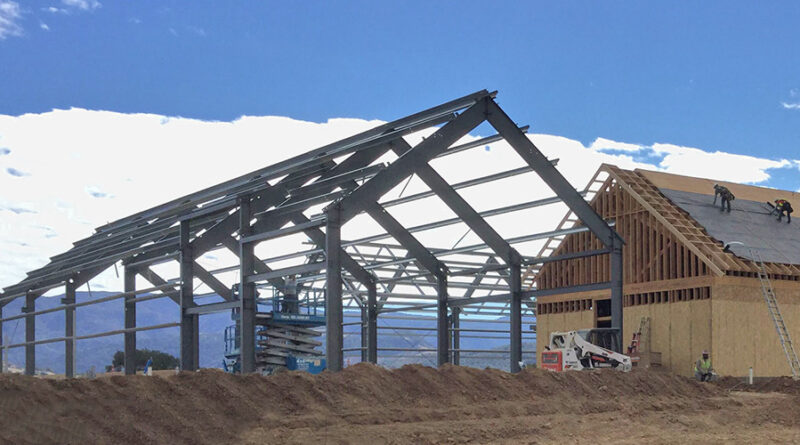Driving Farm Efficiency With Steel Frame Technology: Discover Key Advantages
Steel frame agricultural buildings are transforming the landscape of modern farming. With their unmatched durability and flexibility, these structures offer a practical solution for farmers looking to enhance efficiency and productivity. Unlike traditional wooden barns, steel frames can withstand harsh weather conditions, reducing maintenance costs and ensuring your investment stands the test of time.
But it’s not just about resilience. Steel frame buildings are incredibly versatile, allowing for customisation to meet your specific needs. Whether you need storage for machinery, livestock housing, or a space for crop processing, steel frames provide the adaptability required to optimise your farm operations. By choosing steel, you’re not only investing in a robust structure but also in the future efficiency of your farm.
Overview of Steel Frame Agricultural Buildings
Steel frames in agriculture offer durability and flexibility like no other material. You get structures that resist rust, making them robust against the wear and tear of harsh weather conditions. Unlike wooden structures, steel doesn’t succumb to termites or pests, eliminating costly treatments and repairs.
Steel’s strength allows for large, open spans without the need for internal supports. This gives you more usable space for your equipment, livestock, or goods. Imagine walking into an expansive shed with tall ceilings and no posts blocking your way. That’s the advantage steel brings.
Ease of assembly is another feature. Prefabricated steel parts can be quickly bolted together, reducing construction time. Additionally, steel is recyclable, making it an eco-friendly choice. In the event of changes or expansions, modifications are straightforward and less disruptive.
Importance in Modern Agriculture
Modern agriculture requires efficiency. Crops, machinery, and livestock need dependable shelters that support farming activities. Steel frame buildings play a pivotal role here. By providing a sturdy and lasting home for your resources, they enhance every aspect of farm operations.
Picture how improved storage conditions can significantly impact crop preservation. High-quality steel structures maintain internal climates better, extending the life of your harvest. They’re also ideal for housing expensive machinery, offering protection that prolongs service life and minimises downtime.
Livestock benefit greatly from steel shelters. These buildings protect animals from extreme weather, improving their health and productivity. If your animals could talk, they’d probably thank you for their comfortable living conditions that a well-ventilated, spacious steel structure offers.
Do you find yourself needing versatile space? Steel frame buildings adapt to various farm needs with ease. From processing areas to workshops, their adaptability ensures you maximise every square metre on your property. In modern farming, durability, versatility, and efficiency matter. Steel frames give you the edge to stay competitive and ensure long-term success.
Advantages of Steel Frame Agricultural Buildings
Steel frame agricultural buildings stand the test of time with minimal wear. Steel resists corrosion, pests, and fire better than wood or other materials. Over decades, it maintains integrity, making these buildings a worthwhile investment. You might notice that steel structures often have a lifespan of over 50 years. This extended lifespan means less frequent replacements and repairs. What could be more effective than a structure that endures through years of farming?
Low Maintenance Requirements
Steel needs less upkeep compared to wood or concrete. It does not warp, crack, or rot. Once it’s set up, it does not demand much attention. Occasional checks to ensure bolts and joints remain intact might be all that’s necessary. With fewer maintenance tasks, you can focus more on farm operations. Lower maintenance costs free up funds for other essential areas of your farm. How could farming be more efficient than reducing time spent on repairs?
Enhanced Farming Efficiency
A steel frame provides vast, unobstructed spaces inside. This open design lets you use the space flexibly, whether for storing equipment, housing livestock, or arranging crop storage. The large spaces improve air circulation, which helps maintain better conditions for stored crops and housed animals. Prefabricated parts allow quicker assembly, reducing downtime between planning and usage. Steel’s recyclable nature makes it an eco-friendly choice, aligning with sustainable farming practices. Reflect on the versatility that steel frames bring; they adapt to every need, ensuring you get the most value from your agricultural setup. What other material offers such comprehensive benefits for your farm’s efficiency?
Environmental Impact
Sustainability Features
Steel frames play a vital role in reducing environmental pressure. Their production involves recycled materials which lowers the demand for new resources. When you choose a steel frame, you’re opting for a building that can be repurposed or recycled at the end of its life. This closed-loop system diminishes waste and promotes a sustainable ecosystem.
Unlike wooden structures which require regular treatments to ward off pests and decay, steel does not need chemical inhibitors. This lessens chemical residues in the environment. Additionally, steel’s robustness means it can withstand extreme weather with minimal damage, reducing the need for frequent repairs and conserving resources.
Energy Efficiency
Steel frame buildings excel in energy efficiency. They can incorporate high-quality insulation materials that significantly reduce heating and cooling costs. Thanks to the natural properties of steel, it creates an envelope that retains heat in winter and keeps interiors cool in summer.
You might’ve noticed farmers often face high energy bills. With steel frame structures, those costs can see a noticeable reduction. Reflective roofing options can deflect sunlight, preventing heat buildup. Modular designs allow easy installation of solar panels, further lowering energy consumption and promoting renewable energy use.
Installation of smart ventilation systems is seamless in steel structures. By optimising airflow, these systems keep the indoor environment stable, which is crucial for storing crops and housing livestock. Efficient energy use not only fosters sustainability but also boosts your farm’s bottom line.
Cost Considerations
Investing in steel frame agricultural buildings might seem pricier initially, but they offer long-term savings. Consider the reduced need for repairs. Steel’s resilience against extreme weather means fewer fixes compared to wood or concrete. What about maintenance costs? Thermo-mechanical treatments reduce corrosion, minimising upkeep expenses.
Energy efficiency is another gain. Steel buildings support excellent insulation, cutting heating and cooling costs. Think about installing solar panels or reflective roofs. These options reduce electricity bills over time, enhancing your financial efficiency.
Steel structures last longer. Their inherent durability extends the lifespan of your building, spreading initial investment over many years. Reflect on the peace of mind this offers.
Comparing Costs with Traditional Building Materials
How do steel frames stack up against traditional materials? Wood might be cheaper upfront, but frequent maintenance can rack up costs. Concrete, while sturdy, incurs high transport and installation expenses.
Steel’s lighter weight reduces foundation requirements, saving on construction costs. Have you thought about the ease of assembly? Prefabricated steel components can be quickly put together, slashing labour costs.
When comparing materials, consider longevity. Wood succumbs to pests and rot, demanding replacements. Concrete cracks under stress, requiring patching. Steel’s durability saves on these recurrent expenses.
What about insurance? Steel is non-combustible, possibly lowering insurance premiums. This further drives down the overall cost when compared to flammable wood structures.
Recycling is a hidden gem. Steel frame buildings often use recycled materials, which could offer grant opportunities or tax benefits. Isn’t it satisfying to save money while promoting sustainability?
Assessing the real cost involves looking at more than just the purchase price. When considering long-term efficiency and reduced overheads, steel frames often hold the advantage.
In Closing
Opting for steel frame agricultural buildings significantly boosts farm efficiency. Their durability ensures they withstand harsh weather conditions while requiring minimal maintenance. The flexibility of design allows for customisation to meet your specific needs. Eco-friendly and sustainable steel structures not only reduce your carbon footprint but also offer financial benefits through lower insurance premiums and potential grants. By choosing steel frames, you’re investing in a long-term solution that enhances your farm’s productivity and sustainability.

